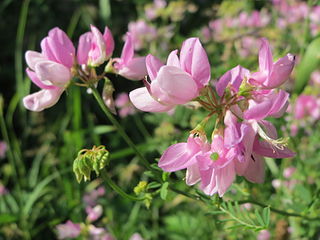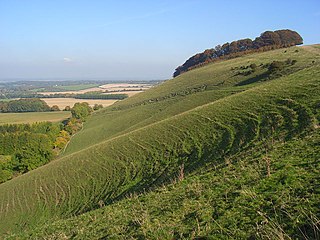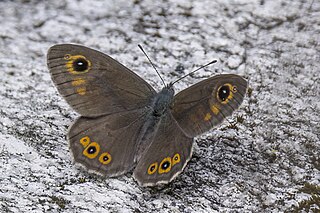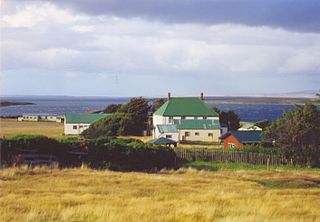
Ornamental grasses are grasses grown as ornamental plants. Ornamental grasses are popular in many colder hardiness zones for their resilience to cold temperatures and aesthetic value throughout fall and winter seasons.

Securigera varia, commonly known as crownvetch or purple crown vetch, is a low-growing legume vine. It is native to Africa, Asia and Europe and is commonly used throughout the United States and Canada for erosion control, roadside planting and soil rehabilitation. It has become an invasive species in many states of the US.

Festuca (fescue) is a genus of flowering plants belonging to the grass family Poaceae. They are evergreen or herbaceous perennial tufted grasses with a height range of 10–200 cm (4–79 in) and a cosmopolitan distribution, occurring on every continent except Antarctica. The genus is closely related to ryegrass (Lolium), and recent evidence from phylogenetic studies using DNA sequencing of plant mitochondrial DNA shows that the genus lacks monophyly. As a result, plant taxonomists have moved several species, including the forage grasses tall fescue and meadow fescue, from the genus Festuca into the genus Lolium, or alternatively into the segregate genus Schedonorus.
NVC community CG7 is one of the calcicolous grassland communities in the British National Vegetation Classification system. It is one of three short-sward communities associated with heavy grazing, within the lowland calcicolous grassland group, and is regarded as the eastern counterpart of "typical" chalk grassland.

Festuca ovina, sheep's fescue or sheep fescue, is a species of grass. It is sometimes confused with hard fescue.
British NVC community MG12 (Festuca arundinacea grassland) is one of the mesotrophic grassland communities in the British National Vegetation Classification system. It is one of three types of mesotrophic grassland classified as grass-dominated inundation communities.

Ham Hill is a hill and area of chalk downland in Wiltshire, England, on the steep banks running alongside the road from the village of Ham to Buttermere, close to the Berkshire border. A biological Site of Special Scientific Interest, notified in 1971, covers 1.5 hectares of the site; this designation is due to the site's species-rich plant and insect communities, which include some rare species. Notable among these is the musk orchid, which has been confirmed at only one other site in Wiltshire.

Lolium pratense, meadow fescue is a perennial species of grass, which is often used as an ornamental in gardens, and is also an important forage crop. It grows in meadows, roadsides, old pastures, and riversides on moist, rich soils, especially on loamy and heavy soils.

Tragus, commonly called bur gras, burr grass or carrot-seed grass, is a genus of plants in the grass family. It is native to Africa, Australia, and Eurasia with several species on islands in the Atlantic, Indian, and Pacific Oceans plus one species in Argentina.

Festuca altaica, also known as the altai fescue, or the northern rough fescue, is a perennial bunchgrass with a wide native distribution in the Arctic, from central Asia to eastern North America. It was first described in 1829 by Carl Bernhard von Trinius. It is under the synonym F. scabrella, the rough fescue.

Festuca rubra is a species of grass known by the common name red fescue, creeping red fescue or the rush-leaf fescue. It is widespread across much of the Northern Hemisphere and can tolerate many habitats and climates. It is best adapted to well-drained soils in cool, temperate climates; it prefers shadier areas and is often planted for its shade tolerance. Wild animals browse it, but it has not been important for domestic forage due to low productivity and palatability. It is also an ornamental plant for gardens.

Festuca californica is a species of grass known by the common name California fescue.

Festuca idahoensis is a species of grass known by the common names Idaho fescue and blue bunchgrass. It is native to western North America, where it is widespread and common. It can be found in many ecosystems, from shady forests to open plains grasslands.

Lasiommata maera, the large wall brown, is a butterfly in the family Nymphalidae.

Tussock grasses or bunch grasses are a group of grass species in the family Poaceae. They usually grow as singular plants in clumps, tufts, hummocks, or bunches, rather than forming a sod or lawn, in meadows, grasslands, and prairies. As perennial plants, most species live more than one season. Tussock grasses are often found as forage in pastures and ornamental grasses in gardens.

Festuca orientalis is a species of flowering plant in the family Poaceae, native to Morocco, West and Central Asia to Pakistan. It was first described in 1794 as Triticum subulatum. As the epithet subulata was already in use for Festuca subulata, the epithet orientalis was adopted when the species was transferred to the genus Festuca. This epithet was first used in 1846 for Nardurus orientalis, the basionym of the present name. Under the synonyms Loliolum orientale or Loliolum subulatum, it was the only species in the genus Loliolum.

Blatačko Lake is a natural lake 21 kilometers to the north-east of Konjic, in Konjic municipality, Bosnia and Herzegovina. The lake is a central feature of the naturally, culturally and historically significant landscape designated as a National Monument of Bosnia and Herzegovina.

Elachista bifasciella is a moth of the family Elachistidae. It is found from Sweden to the Pyrenees, Italy and Romania and from the Netherlands to Poland. It is the type species of the genus Elachista.
Festuca baffinensis also called the Baffin Island fescue is a species of grass in the Poaceae family. The name was published in Bulletin of the National Museum of Canada in 1940. The specific name 'baffinensis' was named after Baffin Island in canada. This species is native Subarctic Northern Hemisphere to W. Central U.S.A. It was first described in 1940 by Polunin.
















